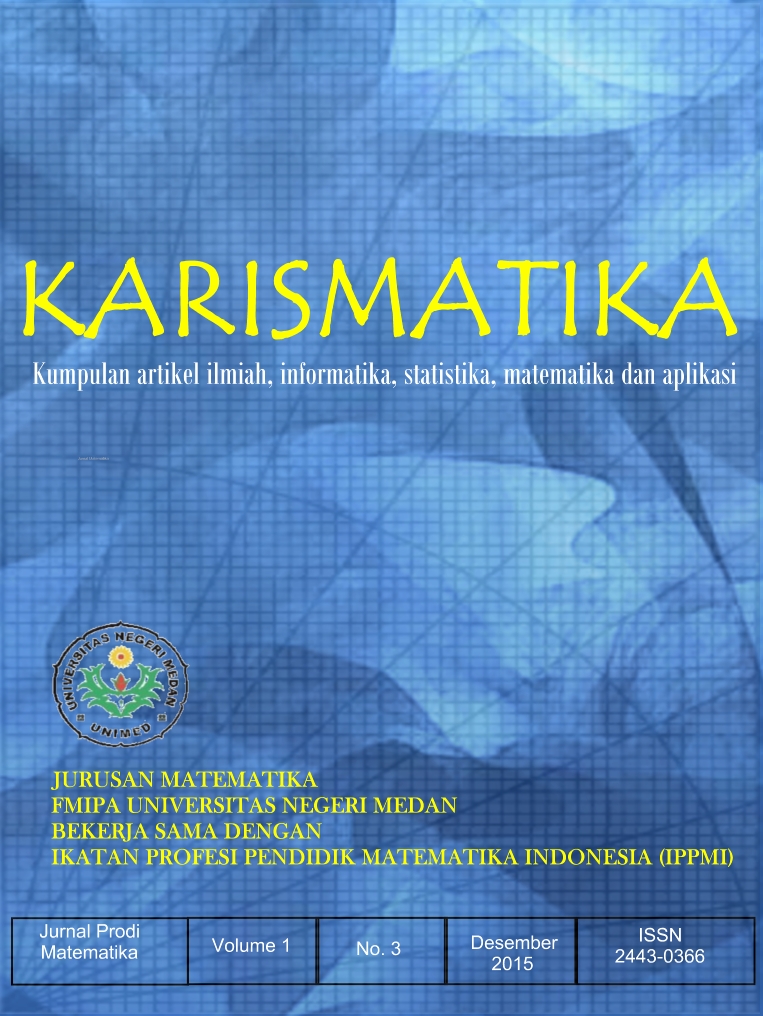Proyeksi Jumlah Penduduk Dan Analisis Faktor Pada Variabel- Variabel Yang Mempengaruhi Pertumbuhan Penduduk Kabupaten Dairi
DOI:
https://doi.org/10.24114/jmk.v2i1.8818Abstract
ABSTRAKTujuan dari penelitian ini adalah menentukan proyeksi jumlah penduduk pada periode yang akan datang dengan menggunakan Trend Non Linear metode polinom (trend parabolik/trend kuadratik) dan mengetahui apakah faktor-faktor (dalam hal ini penyebaran penduduk, kematian, Program KB, pemakaian alat kontrasepsi, keinginan untuk memiliki anak, alasan memiliki anak, sarana dan prasarana, pendapatan/penghasilan, usia ketika menikah, pendidikan terakhir, lingkungan sosial ekonomi, paradigma masyarakat) mempengaruhi pertumbuhan penduduk Kabupaten Dairi. Data yang digunakan untuk proyeksi jumlah penduduk adalah data jumlah penduduk Kabupaten Dairi tahun 2003 hingga tahun 2013. Dari hasil pengolahan data menggunakan Trend Non Linear metode polinom (trend parabolik/trend kuadratik), didapat jumlah penduduk hasil peramalan untuk tahun 2016 yaitu 272.204 jiwa. Berdasarkan jumlah penduduk Kabupaten Dairi pada tahun-tahun sebelumnya, peramalan jumlah penduduk Kabupaten Dairi pada tahun 2016 mengalami penurunan jumlah penduduk. Berdasarkan hasil penelitian variabel-variabel yang mempengaruhi pertumbuhan penduduk Kabupaten Dairi dengan menggunakan analisis faktor didapat bahwa dari 12 variabel yang diteliti ternyata ada 10 variabel yang dapat diuji lebih lanjut. Dan 10 variabel tersebut dapat direduksi menjadi empat faktor. Empat faktor yang terbentuk ini ternyata benar mempengaruhi pertumbuhan penduduk Kabupaten Dairi.Kata kunci : Analisis faktor, Jumlah Penduduk, Trend Non LinearABSTRACTThe aim of this study is to determine the projected total population in future periods using the Trend of Non Linear methods of polynomial (trend parabolic / quadratic trend) and determine whether the factors (in this case the distribution of the population, mortality, program planning, use of contraceptives, the desire to have children, the reason to have a child, infrastructure, revenue / income, age when married, the last education, socio-economic environment, the paradigm of society) affect population growth Dairi. The data used for population projections are the data of population Dairi 2003 to 2013. From the results of data processing using Non Linear Trend method polynomial (parabolic trend / quadratic trend), obtained the total population forecasting results for 2016 is 272 204 inhabitants. Based on the population of Dairi in previous years, forecasting a population of Dairi in 2016 experienced a decline in population. Based on the results of the study variables affecting population growth Dairi using factor analysis found that of the 12 variables studied it turns out there are 10 variables that could be tested further. And 10 variables can be reduced to four factors. Four factors that formed this was correct affecting population growth Dairi. Keywords: factor analysis, Trend Non LinearDownloads
Published
2016-04-10
Issue
Section
Articles
License

This work is licensed under a Creative Commons Attribution 4.0 International License
Authors who publish with this journal agree to the following terms:
- Authors retain copyright and grant the journal right of first publication with the work simultaneously licensed under Creative Commons Attribution 4.0 International License that allows others to share the work with an acknowledgement of the work's authorship and initial publication in this journal.
- Authors are able to enter into separate, additional contractual arrangements for the non-exclusive distribution of the journal's published version of the work (e.g., post it to an institutional repository or publish it in a book), with an acknowledgement of its initial publication in this journal.Penulis.
- Authors are permitted and encouraged to post their work online (e.g., in institutional repositories or on their website) prior to and during the submission process, as it can lead to productive exchanges, as well as earlier and greater citation of published work (Refer to The Effect of Open Access).

